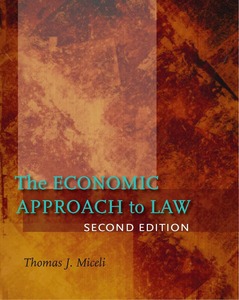Chapter 7
Involuntary Transfers and Regulation of Property
Key Points
• This chapter concerns involuntary transfers of property between private individuals, and coercive acquisitions and regulation of property by the government.
• Adverse possession allows the occupier of a piece of property to acquire legal title if he or she occupies it continuously for a set number of years without objection by the true owner. It thus represents a statute of limitation on the owner’s right to enforce a property rule.
• The economic theory of adverse possession justifies the doctrine as a way of balancing offsetting risks of ownership. These are, on one hand, the risk arising from past claims by legitimate owners; and, on the other, that an absentee owner will lose title to a squatter.
• Owners of land mistakenly improved by another can either pay for the improvements, or require the improver to buy the land at its unimproved value. This rule gives would-be improvers the correct economic incentives regarding whether or not to conduct a survey prior to commencing the improvement.
• Inheritance rules give testators considerable freedom to pass their property on to heirs. Formerly, primogeniture required all land to be passed on to the eldest son. The decline of primogeniture reflects several factors, including the development of land markets which facilitate the transfer and consolidation of land.
• The rule against perpetuities puts a time limit on the ability of testators to control bequests to the lifetime of anyone alive at the time of the bequest plus twenty-one years. The economic purpose of the rule is to limit a testator’s control of resources into the uncertain future.
• The eminent domain (or takings) clause of the Constitution allows the government to take private property for public use as long as just compensation is paid.
• The proper economic justification for eminent domain is to overcome the holdout problem, which impedes the efficient assembly of land. Importantly, this justification does not necessarily limit the use of eminent domain to public projects.
• Courts have defined just compensation to mean the fair market value of a taken parcel. Economists have noted, however, that this measure undercompensates owners by failing to account for the subjective value to their land.
• Recent economic models of eminent domain have shown that compensation must be lump sum in order to avoid a moral hazard problem that would cause landowners to overinvest in land subject to a takings risk. A special case of lump-sum compensation is zero compensation.
• Scholars have raised several objections to the no-compensation result, including the need to prevent the government from taking too much land (fiscal illusion), the benefits of insuring landowners against the risk of a taking, and the demoralization costs of not paying compensation.
• The takings question often arises in the context of government regulations that substantially reduce the value of the regulated property. Courts have developed several tests to determine when a regulation crosses the boundary between a non-compensable police power action and a compensable taking (referred to as a regulatory taking).
• Economic theory shows that both efficient land use incentives and efficient takings decisions can be achieved by a threshold compensation rule that only requires compensation to be paid if the regulation was enacted inefficiently. The result is reminiscent of the efficiency of negligence rules in tort law.
• In terms of explaining actual takings law, the efficient threshold rule resembles the famous diminution value test, as well as other legal tests for compensation.
• Capitalization of the compensation rule into the market price for land does not make the compensation rule irrelevant because the owner of the land at the time the threat of a regulation is first announced suffers a capital loss.
• Zero compensation for land use regulation creates a risk that landowners will develop prematurely in an effort to pre-empt the regulation.
• Government regulation is preferred to common law control when harm is dispersed, given the cost of collective action by victims. The disadvantage of regulation is that it generally imposes a single standard applicable to all injurers, resulting in too little care by some and not enough by others.
